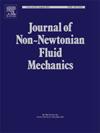Enhanced double distribution function lattice Boltzmann method for simulation of viscoelastic and shear-thinning fluids flow
IF 2.8
2区 工程技术
Q2 MECHANICS
引用次数: 0
Abstract
In this study, we use a two-dimensional multiple relaxation time (MRT) approach for simulating polymeric fluids. A correction term is introduced into the source term to remove non-physical terms and improve numerical accuracy of the simulations. The correction term preserves the locality of the collision process and ensures numerical stability across a range of Weissenberg numbers when coupled with non-linear constitutive equations.
This approach is applied to the Phan-Thien-Tanner (PTT) model and the Oldroyd-B model, where the first exhibits viscoelastic and shear-thinning behavior while the second is purely viscoelastic. To evaluate the numerical accuracy and stability of the proposed MRT-LBM approach, we apply it to planar Poiseuille flow as well as simplified four-roll mill benchmarks. In the case of the four-roll mill, we specifically examine the effects of shear-thinning and viscoelasticity in steady elongational flows and their transitions to oscillatory and chaotic or turbulent behaviors, known as elastic instability. Our results indicate that the non-linearity in the stress-strain rate relationship and the microstructural dynamics of polymer chains, as described by non-linear constitutive models, make the standard BGK-LBM approach incapable to accurately capture the complex behavior of polymers without introducing numerical artifacts. On the other hand the MRT-LBM method maintains numerical stability and accuracy across a broad range of Weissenberg (up to ) and should therefore be the method of choice when simulating these types of flows.
粘弹性和剪切稀化流体流动模拟的增强双分布函数晶格玻尔兹曼方法
在这项研究中,我们使用二维多重弛豫时间(MRT)方法来模拟聚合物流体。在源项中引入校正项,消除了非物理项,提高了模拟的数值精度。校正项保留了碰撞过程的局部性,并确保了当与非线性本构方程耦合时,在Weissenberg数范围内的数值稳定性。该方法适用于Phan-Thien-Tanner (PTT)模型和Oldroyd-B模型,前者表现为粘弹性和剪切减薄行为,而后者则是纯粘弹性的。为了评估所提出的MRT-LBM方法的数值精度和稳定性,我们将其应用于平面泊泽维尔流和简化的四辊轧机基准。在四辊轧机的情况下,我们特别研究了剪切变薄和粘弹性在稳定拉长流动中的影响,以及它们向振荡和混沌或湍流行为的转变,即弹性不稳定性。我们的研究结果表明,非线性本构模型所描述的应力-应变速率关系和聚合物链微观结构动力学的非线性,使得标准的BGK-LBM方法在不引入数值伪影的情况下无法准确捕捉聚合物的复杂行为。另一方面,MRT-LBM方法在广泛的Weissenberg范围内(高达Wi=20)保持数值稳定性和准确性,因此应该是模拟这些类型流动时的首选方法。
本文章由计算机程序翻译,如有差异,请以英文原文为准。
求助全文
约1分钟内获得全文
求助全文
来源期刊
CiteScore
5.00
自引率
19.40%
发文量
109
审稿时长
61 days
期刊介绍:
The Journal of Non-Newtonian Fluid Mechanics publishes research on flowing soft matter systems. Submissions in all areas of flowing complex fluids are welcomed, including polymer melts and solutions, suspensions, colloids, surfactant solutions, biological fluids, gels, liquid crystals and granular materials. Flow problems relevant to microfluidics, lab-on-a-chip, nanofluidics, biological flows, geophysical flows, industrial processes and other applications are of interest.
Subjects considered suitable for the journal include the following (not necessarily in order of importance):
Theoretical, computational and experimental studies of naturally or technologically relevant flow problems where the non-Newtonian nature of the fluid is important in determining the character of the flow. We seek in particular studies that lend mechanistic insight into flow behavior in complex fluids or highlight flow phenomena unique to complex fluids. Examples include
Instabilities, unsteady and turbulent or chaotic flow characteristics in non-Newtonian fluids,
Multiphase flows involving complex fluids,
Problems involving transport phenomena such as heat and mass transfer and mixing, to the extent that the non-Newtonian flow behavior is central to the transport phenomena,
Novel flow situations that suggest the need for further theoretical study,
Practical situations of flow that are in need of systematic theoretical and experimental research. Such issues and developments commonly arise, for example, in the polymer processing, petroleum, pharmaceutical, biomedical and consumer product industries.

 求助内容:
求助内容: 应助结果提醒方式:
应助结果提醒方式:


